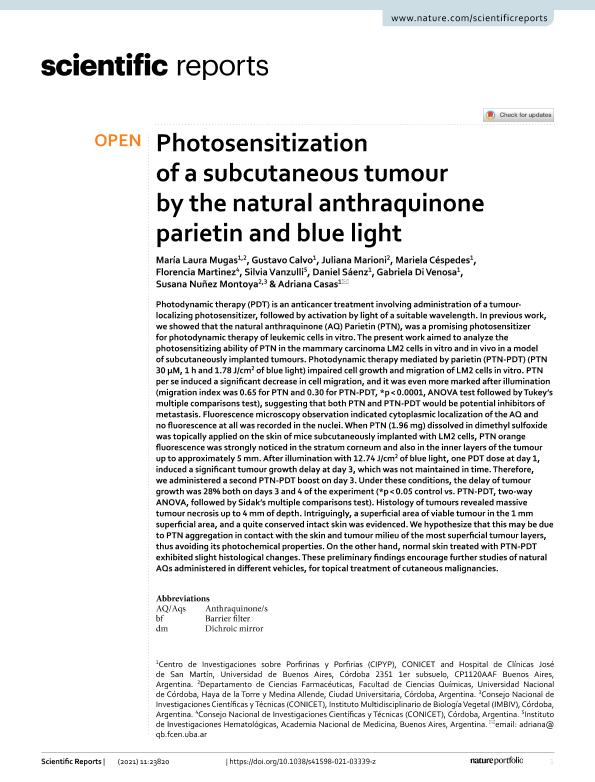Artículo
Photosensitization of a subcutaneous tumour by the natural anthraquinone parietin and blue light
Mugas, María Laura ; Calvo, Gustavo Hernán
; Calvo, Gustavo Hernán ; Marioni, Juliana
; Marioni, Juliana ; Céspedes, Mariela Anahí; Martinez, Florencia
; Céspedes, Mariela Anahí; Martinez, Florencia ; Vanzulli, Silvia; Saenz, Daniel Alberto
; Vanzulli, Silvia; Saenz, Daniel Alberto ; Di Venosa, Gabriela Mariana
; Di Venosa, Gabriela Mariana ; Núñez Montoya, Susana Carolina
; Núñez Montoya, Susana Carolina ; Casas, Adriana Gabriela
; Casas, Adriana Gabriela
 ; Calvo, Gustavo Hernán
; Calvo, Gustavo Hernán ; Marioni, Juliana
; Marioni, Juliana ; Céspedes, Mariela Anahí; Martinez, Florencia
; Céspedes, Mariela Anahí; Martinez, Florencia ; Vanzulli, Silvia; Saenz, Daniel Alberto
; Vanzulli, Silvia; Saenz, Daniel Alberto ; Di Venosa, Gabriela Mariana
; Di Venosa, Gabriela Mariana ; Núñez Montoya, Susana Carolina
; Núñez Montoya, Susana Carolina ; Casas, Adriana Gabriela
; Casas, Adriana Gabriela
Fecha de publicación:
10/12/2021
Editorial:
Nature Publishing Group
Revista:
Scientific Reports
ISSN:
2045-2322
Idioma:
Inglés
Tipo de recurso:
Artículo publicado
Clasificación temática:
Resumen
Photodynamic therapy (PDT) is an anticancer treatment involving administration of a tumourlocalizing photosensitizer, followed by activation by light of a suitable wavelength. In previous work, we showed that the natural anthraquinone (AQ) Parietin (PTN), was a promising photosensitizer for photodynamic therapy of leukemic cells in vitro. The present work aimed to analyze the photosensitizing ability of PTN in the mammary carcinoma LM2 cells in vitro and in vivo in a model of subcutaneously implanted tumours. Photodynamic therapy mediated by parietin (PTN-PDT) (PTN 30 µM, 1 h and 1.78 J/cm2 of blue light) impaired cell growth and migration of LM2 cells in vitro. PTN per se induced a significant decrease in cell migration, and it was even more marked after illumination (migration index was 0.65 for PTN and 0.30 for PTN-PDT, *p < 0.0001, ANOVA test followed by Tukey?s multiple comparisons test), suggesting that both PTN and PTN-PDT would be potential inhibitors of metastasis. Fluorescence microscopy observation indicated cytoplasmic localization of the AQ and no fluorescence at all was recorded in the nuclei. When PTN (1.96 mg) dissolved in dimethyl sulfoxide was topically applied on the skin of mice subcutaneously implanted with LM2 cells, PTN orange fluorescence was strongly noticed in the stratum corneum and also in the inner layers of the tumour up to approximately 5 mm. After illumination with 12.74 J/cm2 of blue light, one PDT dose at day 1, induced a significant tumour growth delay at day 3, which was not maintained in time. Therefore, we administered a second PTN-PDT boost on day 3. Under these conditions, the delay of tumour growth was 28% both on days 3 and 4 of the experiment (*p < 0.05 control vs. PTN-PDT, two-way ANOVA, followed by Sidak?s multiple comparisons test). Histology of tumours revealed massive tumour necrosis up to 4 mm of depth. Intriguingly, a superficial area of viable tumour in the 1 mm superficial area, and a quite conserved intact skin was evidenced. We hypothesize that this may be due to PTN aggregation in contact with the skin and tumour milieu of the most superficial tumour layers, thus avoiding its photochemical properties. On the other hand, normal skin treated with PTN-PDT exhibited slight histological changes. These preliminary findings encourage further studies of natural AQs administered in different vehicles, for topical treatment of cutaneous malignancies.
Palabras clave:
ANTHRAQUINONE
,
PARIETIN
,
PHOTOSENSITIZER
,
SUBCUTANEOUS TUMOUR
Archivos asociados
Licencia
Identificadores
Colecciones
Articulos(IMBIV)
Articulos de INST.MULTIDISCIPL.DE BIOLOGIA VEGETAL (P)
Articulos de INST.MULTIDISCIPL.DE BIOLOGIA VEGETAL (P)
Citación
Mugas, María Laura; Calvo, Gustavo Hernán; Marioni, Juliana; Céspedes, Mariela Anahí; Martinez, Florencia; et al.; Photosensitization of a subcutaneous tumour by the natural anthraquinone parietin and blue light; Nature Publishing Group; Scientific Reports; 11; 1; 10-12-2021; 1-13
Compartir
Altmétricas



